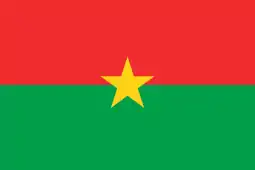Burkinabe cuisine
Burkinabé cuisine, the cuisine of Burkina Faso, is similar to the cuisines in many parts of West Africa, and is based on staple foods of sorghum, millet, rice, fonio, maize, peanuts, potatoes, beans, yams and okra.[1] Rice, maize and millet are the most commonly eaten grains.[2] Grilled meat is common, particularly mutton, goat, beef and fish.[3] Vegetables include, besides yams and potatoes, okra, tomatoes, zucchini, carrots, leeks, onions, beets, pumpkins, cucumbers, cabbage, sorrel and spinach.[2] Although imported products are becoming more common in urban areas, meals in more rural areas typically consist of tô, a sauce of corchorus or baobab leaves, as well as the calyx from Bombax costatum, dried fish, and spices such as chili and soumbala.[4]
| Part of a series on the |
| Culture of Burkina Faso |
|---|
 |
| History |
| People |
| Languages |
| Cuisine |
| Religion |
| Art |
| Literature |
| Sport |
Common dishes


- Tô (food) (Saghbo in Mooré), cooled polenta-style cakes made from ground millet, sorghum or corn. The tô is served with a sauce made from vegetables such as tomatoes, peppers, sumbala and carrots, sometimes supplemented by a piece of meat like mutton or goat.[5] Eaten by hand, this traditional dish is the staple of the Burkinabè diet.[3]
- French green beans
- Fufu
- Poulet Bicyclette, a grilled chicken dish common across West Africa.[3]
- Ragout d'Igname, a yam stew dish native to Burkina
- Riz gras, rice cooked with onions, tomatoes and meat.[2][3]
- Riz Sauce
- Sauce gombo, a sauce made with okra.
- Brochettes
- Poulet Braisé, grilled chicken very popular in the city, almost all restaurants and bars propose that dish.
- Babenda, a stew of fermented beans, fish, cabbage, and/or spinach.[6]
Restaurants generally serve Burkinabé dishes alongside those of neighbouring countries. Foreign dishes include a fish or meat stew called kédjénou from Côte d'Ivoire and poulet yassa, a chicken stew with lemon and onions from Senegal.[3]
 The fruit of the African Baobab tree
The fruit of the African Baobab tree Foods being cooked in Burkina Faso
Foods being cooked in Burkina Faso Preparing tö
Preparing tö
Common beverages
- Bissap/Bisap, a sour-tasting drink made from Roselle (Bissap) flowers in the Hibiscus family,[7] and sweetened with sugar
- Degue, a drink made from pearl millet and yogurt
- Dôlo, a beer made from pearl millet or sorghum[8]
- Tédo, also called Pain de Sainge, Baobab fruit
- Yamaccu or Yammaccudji, beverage made of Ginger
- Zomekome, a soft drink made from millet flour, ginger, lemon juice and tamarind[1]
- Tamarin,
- Jus de Weda or Jus de Liane
See also
References
- "Oxfam's Cool Planet - Food in Burkina Faso". Oxfam. Archived from the original on 2012-05-17. Retrieved 2008-05-21.
- Liza Debrevic. "Burkina Faso". In Ken Albala (ed.). Food Cultures of the World. ABC-CLIO. pp. 23–30.
- Marchais, Julien. Burkina Faso (in French). Petit Futé. p. 99. ISBN 2-7469-1601-0.
- Mette Lykke, Anne; Mertz, Ole; Ganaba, Souleymane (2002). "Food consumption in rural Burkina Faso". Ecology of Food and Nutrition. 41 (2): 119–153. doi:10.1080/03670240214492.
- Gibbon, Ed (2005). The Congo Cookbook: African Food Recipes. OCLC 761178200.
- "Burkina Faso Food and Drink". World Travel Guide. 2019. Retrieved 2019-01-16.
- Grubben, G. J. H. (2004). Vegetables: Vegetables (PROTA 2). PROTA. p. 321. ISBN 90-5782-147-8.
- Steinkraus, Keith (2004). Industrialization of Indigenous Fermented Foods. CRC Press. p. 273. ISBN 0-8247-4784-4.